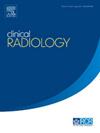低剂量计算机断层扫描(CT)血管造影中基于迭代模型重建的Adamkiewicz动脉可视化
IF 1.9
3区 医学
Q2 RADIOLOGY, NUCLEAR MEDICINE & MEDICAL IMAGING
引用次数: 0
摘要
基于迭代模型的重建(IMR)用于Adamkiewicz动脉(AKA)的低剂量计算机断层扫描(CT)血管成像仍有待研究。因此,我们的目的是在低剂量CT协议下,使用一种新的基于知识的IMR与使用混合迭代重建(iDose4)和滤波后投影(FBP)的图像质量和AKA可视化进行比较。材料与方法采用低剂量(100 kVp, 20 mA) 256层多排CT检查的主动脉瘤或夹层患者45例(男性73.3%)。使用FBP、iDose4和IMR重建获得的原始数据,并由两名观察员进行盲法分析。定量分析评估在多平面重构图像上主动脉的信噪比(SNR)和脊髓前动脉测量相对于脊髓的信噪比(CNR)。定性分析采用四分制评估AKA的显像及其与肋间动脉或腰动脉的连续性。结果在定量分析中,IMR的信噪比和CNR均为(信噪比:35.2±10.2;信噪比:3.8±0.5)显著高于iDose4(信噪比:21.5±4.9;信噪比:3.1±0.8)和FBP(信噪比:14.1±3.1;CNR: 2.6±0.8)(均为P<; 0.05)。在定性分析中,IMR组的AKA平均可视化评分(3.6±0.6)也明显优于iDose4组(3.1±0.8)和FBP组(2.6±0.8)(P< 0.05)。可评估的AKA患病率在IMR中最高(93.3%),其次是iDose4(75.6%)和FBP(51.1%)。结论与iDose4和FBP相比,IMR算法在低剂量CT血管造影中具有更好的图像质量和AKA可视化效果。本文章由计算机程序翻译,如有差异,请以英文原文为准。
Adamkiewicz artery visualisation using iterative model–based reconstruction in low-dose computed tomograpyhy (CT) angiography
AIM
The use of iterative model–based reconstruction (IMR) for the artery of Adamkiewicz (AKA) visualisation using low-dose computed tomography (CT) angiography remains understudied. Therefore, we aimed to compare the image quality and AKA visualisation using a novel knowledge-based IMR with those using hybrid iterative reconstruction (iDose4) and filtered back projection (FBP) under a low-dose CT protocol.
MATERIALS AND METHODS
Forty-five patients (73.3% male) with aortic aneurysm or dissection who underwent 256-slice multidetector row CT with a low-dose CT protocol (100 kVp and 20 mA) were enrolled. The acquired raw data were reconstructed using FBP, iDose4, and IMR and blindly analysed by two observers. Quantitative analysis assessed signal-to-noise ratio (SNR) of the aorta and contrast-to-noise ratio (CNR) of the anterior spinal artery measurement relative to the spinal cord on multiplanar reformatted images. Qualitative analysis evaluated AKA visualisation and its continuity with the intercostal or lumbar artery using a four-point scale.
RESULTS
In the quantitative analysis, both SNR and CNR of IMR (SNR: 35.2 ± 10.2; CNR: 3.8 ± 0.5) were significantly higher than those of iDose4 (SNR: 21.5 ± 4.9; CNR: 3.1 ± 0.8) and FBP (SNR: 14.1 ± 3.1; CNR: 2.6 ± 0.8) (all P<.05). In the qualitative analysis, the mean AKA visualisation score was also significantly better in IMR (3.6 ± 0.6) than in iDose4 (3.1 ± 0.8) and FBP (2.6 ± 0.8) (P<.05). The prevalence of assessable AKA was the highest in IMR (93.3%), followed by iDose4 (75.6%) and FBP (51.1%).
CONCLUSION
The IMR algorithm provided superior image quality and AKA visualisation compared with iDose4 and FBP when using low-dose CT angiography.
求助全文
通过发布文献求助,成功后即可免费获取论文全文。
去求助
来源期刊

Clinical radiology
医学-核医学
CiteScore
4.70
自引率
3.80%
发文量
528
审稿时长
76 days
期刊介绍:
Clinical Radiology is published by Elsevier on behalf of The Royal College of Radiologists. Clinical Radiology is an International Journal bringing you original research, editorials and review articles on all aspects of diagnostic imaging, including:
• Computed tomography
• Magnetic resonance imaging
• Ultrasonography
• Digital radiology
• Interventional radiology
• Radiography
• Nuclear medicine
Papers on radiological protection, quality assurance, audit in radiology and matters relating to radiological training and education are also included. In addition, each issue contains correspondence, book reviews and notices of forthcoming events.
 求助内容:
求助内容: 应助结果提醒方式:
应助结果提醒方式:


